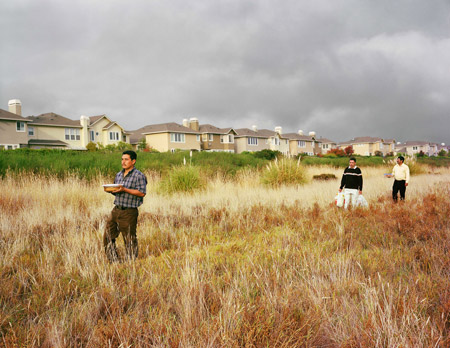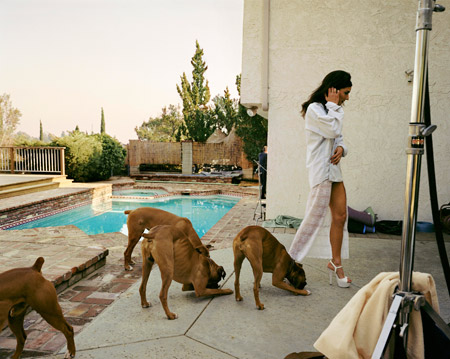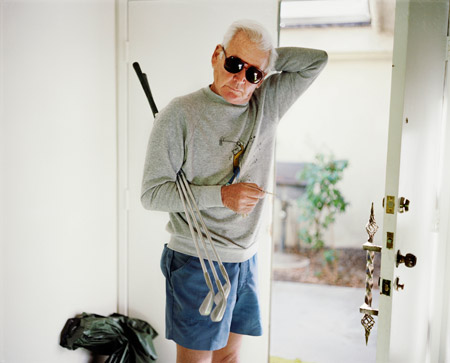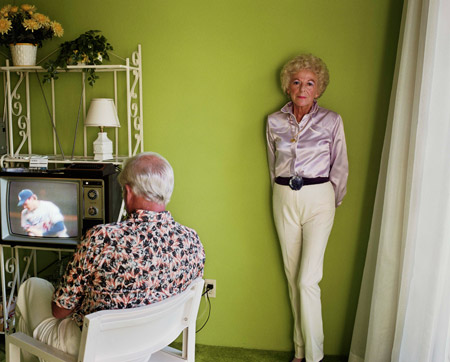You can smell the photographs of Larry Sultan. My wife noticed this before I did. She is a Western person (she grew up in Las Vegas). That’s to say, she’s a desert person, as am I (Los Angeles). So it makes sense that she could smell Sultan’s pictures. Most of the photographs of Larry Sultan (currently on display at LACMA’s retrospective Larry Sultan: Here and Home) are thick with the San Fernando Valley in North Los Angeles, where Sultan grew up.
- “Larry Sultan: Here and Home” at the Los Angeles Museum of Contemporary Art, Los Angeles. Through March 22.
The San Fernando Valley, otherwise known to Angelinos simply as “The Valley,” is Ground Zero for West Coast suburbia. There are tract homes, model housing developments, vast stretches of concrete highway stretching out into the horizon. But if you look hard enough, or move to the edges of the Valley, there is always the desert, the scrub brush and the dryness. That is, after all, what lies underneath Los Angeles if you could just scrape the city off.
When I look at photographs by Larry Sultan I smell eucalyptus and lavender. Those are the plants I can name. I also smell the gnarled bushes and brown weeds, the nameless desert flowers that grew in the nooks and crannies of Laurel Canyon, in the places that hadn’t been watered and replanted by homeowners. Running around in the behind-spaces of the Hollywood Hills as a youth, I smelled all those smells, got them on my fingers. It is strange that a photograph, something that cannot be smelled or touched or tasted, could recall those sensations. But those dirt-dusted plant smells are in every frame of Sultan’s photographic series Pictures from Home (1982-92), The Valley (1998-2003), and Homeland (2006-9).
Larry Sultan died of cancer in 2009; the Homeland series constitutes his final testimony. The smelliest of the Homeland pictures is, for me, Creek, Santa Rosa (2007). Santa Rosa is actually up in Northern California, but Sultan shot it to look more or less the same as L.A.’s Valley. The picture shows a half-dried creek behind a housing development. A youngish Latino man crouches down with a bucket. Presumably, he is gathering water. Another man is heading up the hill behind, his bucket already full. In terms of content, the picture is not unlike something you might see in a 17th century painting. European villagers drawing water from a nearby river. Something painted, maybe, by Claude Lorrain.
But in a picture by Claude Lorrain, the villagers drawing the water are fully integrated into the landscape. With Claude, people belong to place and place belongs to people. The paintings work because everything holds together in a neo-classical pictorial oneness. It doesn’t work that way in a picture by Larry Sultan. The two men in Creek, Santa Rosa are drawing water from the creek because they don’t have access to the taps in the modern homes just behind them. They don’t live in those homes. They don’t fully belong. They are day laborers living at the margins of the suburbia they both serve (as workers to be hired on the cheap) and aspire to (as immigrants trying to make a better life). Larry Sultan got his models for these photographs by driving to those places (parking lots, bus stops) in California where day laborers stand around waiting to be hired for whatever temporary work is available.
Creek, Santa Rosa is thus saturated with desire and longing only half-fulfilled — and probably, in the end, unfulfillable. How many of California’s day laborers ever come to own a big house in one of those sprawling developments? Of those who do, how many are fully satisfied by the achievement? Sociologically and economically, then, these pictures are made tense by the realities of labor, class, exploitation, and consumerism. But the pictures cannot be reduced to that sociological impulse. Larry Sultan is not a photojournalist.

Canal District, San Rafael. From the series Homeland, 2006. Image © and courtesy the Estate of Larry Sultan.
Here’s what Sultan wrote about the pictures of Homeland:
They are deeply reminiscent of the terrain I sought out as a child: the empty fields behind malls and scruffy borderlands of the LA river that ran behind my house in the San Fernando Valley. These places represented a small and vanishing patch of paradise that existed just outside of the boundaries of property and ownership; a free zone that eased my (adolescent) uncertainty and provided a safe place away from the judgments of others.
So, Larry Sultan had his own desires. In the case of Homeland , this adds a further layer of complication to the pictures. In another photograph from the series, Canal District, San Rafael (2007), a trio of day laborers carries plates of food across one of Sultan’s scruffy borderlands at the edge of a housing development. The immediate thought, on looking at the picture, is that these three men should be allowed inside one of the homes in the background. They want to be inside, eating their food in the dining room, and we want them to be there, too.
But the second thought is that those homes, the over-manicured spaces of the giant housing developments, are not the paradise they claim to be. The day laborers are, actually, the people who get to enjoy Sultan’s “vanishing patch of paradise.” They are the lucky ones, though that luck is tempered with regret, since it is made possible by what they cannot have, what they cannot afford.
In his now-canonical book about Los Angeles, City of Quartz (1990), Mike Davis argued that L.A., throughout its history, has tended to drive people into opposing camps. On the one side are what Davis calls the “boosters.” These are the cheerleaders for Los Angeles, the people who claim that a better life really can be found in the sunshine of the L.A. basin. On the other side are what Davis calls the “noir” set. These are the people who see in Los Angeles a living hell, a dark dystopia of frustrated and improper desires. Davis also identifies a number of groupings that fall somewhere in between those two poles, Exiles, Communards, etc.
Ever since Los Angeles started to grow as a city in the early part of the 20th century, it presented itself as a solution to the problems found everywhere else. You end up in Los Angeles because you are seeking the good life. Your attitude, once you get there, tends to reflect either a defense of L.A.’s inherent utopian quality, or an attack on the very idea that Los Angeles is a solution to anything.

Boxers, Mission Hills. From the series The Valley, 1999. Image © and courtesy the Estate of Larry Sultan.
Los Angeles, then, is a city that has to deal with the problem of its own desire more explicitly than other cities. This is true of California in general, but Los Angeles is the headquarters of the idea. People move to Cleveland all the time. But Cleveland is not a city “about” wanting to be in Cleveland. Los Angeles is a city “about” wanting to be in Los Angeles. Even for the people who hate Los Angeles, the hate is still structured in terms of desire — the desire has just turned into an aggressive rejection.
To have any interest in Los Angeles — in how it looks, how it feels, how it operates – you have to be interested in the wanting and not-wanting that drives the soul of the place. That is something Larry Sultan understood.
Take his series Pictures from Home (1982-92). These are photos taken at his parents’ home in the San Fernando Valley. Many of the photographs are portraits of his mother, his father, or both. One shot, Dad With Raft (1987), shows just that: Sultan’s father is standing on the veranda in his swimming trunks, a towel draped over his shoulder, a blue inflatable raft tucked under his right arm. The photo is shot from inside the house, through a pane glass window that frames Dad as he takes his epic journey to the pool. It is the apotheosis of the Southern California lifestyle: the sunshine, the luxuriant green bushes, the promise of days spent frolicking in warmth and water. All the signs of contentment are captured in the picture. It is also an immensely depressing photograph. I think it is the way that Sultan’s father’s leathery old feet stick out in the bottom section of the pane glass window. Those feet peek out like the loneliness of death itself, mocking the achievement in the top two-thirds of the picture. There’s also an air of empty despondency in the way that Sultan has posed his father. Intentional, of course, but just right.
Interviewed once by Catherine Liu for Bomb Magazine, Sultan objected when Liu suggested that his pictures are without artifice. “I disagree,” Sultan said.
That ambiguity is interesting to me. I use the suburban house very much as a stage. I’m conscious of what the bedroom signifies and how it’s arranged. I do see it as a theater. Sometimes they’re not posed at all, yet those can look the most posed.
That’s to say, Sultan doesn’t want his photos to look like objective documentation of what’s there. He wants his pictures to look like pictures, to be representations fully aware that they are representations. This is something that a formalist critic like Michael Fried would appreciate in Sultan’s work. These are photographs that present themselves self-consciously as works of art.

Dad with Golf Clubs. From the series The Valley, 1999. Image © and courtesy the Estate of Larry Sultan.
Another photograph from Pictures From Home is titled Practicing Golf Swing (1986). It shows Sultan’s father in the living room, barefoot on a green carpet, golf club raised over his head as he practices a shot. A television in the corner shows what seems to be the news, perhaps a business report. Diaphanous drapes are drawn across the large, sliding glass windows that backdrop the scene. These might be the same panes of glass that frame Sultan’s father in Dad With Raft. Practicing Golf Swing shows “the life.” This is why people move to Southern California. The comfort, the ease, the sunny days filled with golf all year round. Part of what Sultan captures in his picture is that living “the life” is about acting a part. Sultan poses his father in that room practicing his golf swing because that is how Sultan imagines his father seeing himself. That’s the life his father wants.
The interesting thing about photography is that, once you’ve posed the scene, once you’ve managed to create the picture you want to create, it begins to fall apart. Photographs, because they visually record everything set before them, always contain more information than the photographer can control. Knowing this, Sultan posed his pictures to record the fantasy of “the life” while realizing that he was also capturing the reality that comes with it. Sultan, in short, was always aware that the image of “the Southern California life” doesn’t hold up. When you try to capture the fantasy, it can’t stand on its own two feet. In this case, the metaphor is literal. Sultan’s father happened to own a pair of chicken legs. His legs are like skinny, fragile sticks. Twisting his body in that golf pose, Sultan’s father looks like he is about to break, to collapse. Like in Dad With Raft, death intrudes into the picture just at the wrong moment. The picture turns melancholy at its moment of triumph.
The net result of the collapse in Practicing Golf Swing neither demeans Sultan’s father’s desire for “the life” nor celebrates it. In the aforementioned interview, Sultan said of his Pictures from Home series:
What is crucial here is that this is my family, these are my parents, and I care deeply for them. I have an enormous argument with their culture (perhaps it’s my culture as well), but I have something else, too, compassion. It’s the depth of love.

Larry Sultan, My Mother Posing for Me, from the series Pictures from Home, 1984,
chromogenic print, 40 x 50 in., © Estate of Larry Sultan, photo courtesy the Estate of Larry Sultan
Larry Sultan’s pictures of his parents are beautiful because he identifies with their desires. He understands. Plus, Sultan has his own desires, his own nostalgia about the San Fernando Valley, about his parents’ home, about the family wish to have a good life. Sultan’s pictures attempt to do justice to the authenticity of that wanting. But, being art, the pictures are self-conscious. They reveal the wanting with such remorseless accuracy that the wanting collapses in on itself. We see the desperation too.
That’s something that happens to everyone in Los Angeles. If you chase your desire to the place called Los Angeles, you will eventually have to face the thinness and the arbitrary nature of your desire, of your self. Los Angeles is a cruel mirror that way. There is glamor and there is sun, and life thrives in all its strange variety. But there is a desert underneath, with brown scrub brush and thistles and cracked earth dry as bones. • 22 January 2015




